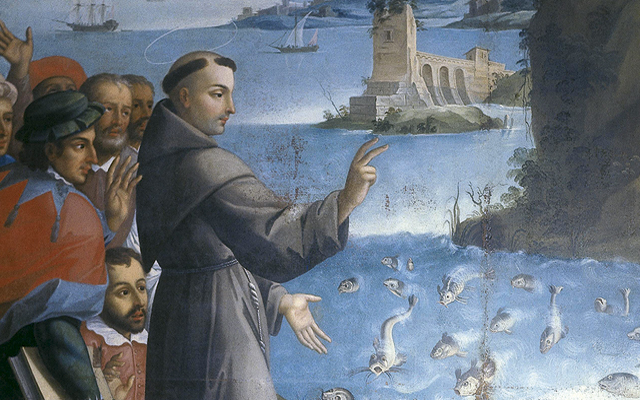Reel Life: The link between religion and fish
David Profumo explores the link between religion and fish.


Saint Cuthbert has his otter, Anastasia her faggots and poor old Elmo holds the windlass onto which his martyred entrails were wound; then, there’s Gertrude with her taper, Benedict’s broken sieve and the pomegranate of St Juan de Dios.
Saints’ emblems can seem outlandish, but this month commemorates two that are associated with fish—St Zeno (April 12) and St Mellitus (April 24).
By my reckoning, there are some 34 saints with piscine attributes, ranging from St Amelberga’s sturgeon to the golden eel of St Spiridion. Andrew totes a net and Simon Peter a fish, signifying his apostolic calling. Francis of Assisi (an early advocate of ‘kiss and release’), Eanswith (abbess of Folkestone), Archbishop Wilfrid (who taught the Saxons to be anglers) and even the Archangel Raphael are other watery notables.
Tired of inattentive congregations, Anthony of Padua preached to the fishes of the Adriatic, which ‘bowed down their heads‘ in devotion. The Cornish hermit Neot—diminutive tutor to King Alfred—left as his relic a comb fashioned from pikes’ teeth.
Strathclyde’s Kentigern retrieved a royal ring from a salmon and died in his bath, aged 185. Even before hagiography, the fish was an ancient cultural symbol embracing astrology, augury, Hindu deities, the pagan cult of Dagon and the fertility rites of Venus (that Vesica piscis icon may well have enjoyed vaginal undertones).
Fish feature worldwide in Creation myths—the Greek letter alpha, signifying the Beginning, resembles a fish. It is, therefore, likely that Christianity assimilated such icthyolatrous connotations and forged them anew.
In the Old Testament, we find Leviathan, the apocryphal saga of Tobit (involving fumigation via fish-guts) and Jonah’s ‘whale’, that prefigures the Resurrection. The Gospels give us miraculous accounts of the Draught of Fishes, the Feeding of the Five Thousand and the summoning of the Zebedee brothers ‘I will make you fishers of men’.
Exquisite houses, the beauty of Nature, and how to get the most from your life, straight to your inbox.
Paintings of the Last Supper often featured fish as part of the first Sacrament, sometimes with Judas purloining one beneath the tablecloth. They later betokened for the faithful who could not read—everything from the Eucharist to the Trinity and were frequently inscribed on baptismal fonts.
The sign for the acrostic Ichthys (Iesous Christos Theou Yios Soter or Jesus Christ, Son of God, Saviour) was adopted as an identifying motif by early Christians in times of persecution; easily formed as two intersecting arcs, it disappeared from mainstream use in about the 4th century, but has enjoyed a modern revival—including a number of parodic versions on bumper stickers that proclaim a devotion to Darwin, Rasta or Star Wars.
Down the ages, the established Church continued its identification with fish through its imposition of meatless ‘fast days‘ (at one period, these accounted for half the entire calendar) and the monastic diet, which relied heavily on pisciculture.
Angling was sanctioned as a profitable, contemplative activity and some authors notably that staunch Anglican, Walton—traded on the supposed piety of their preferred pastime. There persists a long line of distinguished angling divines, from Donne through Swift to Kingsley: my Perthshire neighbour is both a Reverend Canon and a member of the Flyfishers’ Club.
And so to St Mellitus—the 7th-century Roman missionary who founded Westminster Abbey. One night in a vision, a Thames netsman named Aldrich was instructed by St Peter to row across to Thorney Island, where he beheld a great new church lit by angels.
He captured a salmon and was instructed to take it to Mellitus and show him the spot where he should build his new minster and, for centuries, the fishermen of that river continued to give a tithe of their catches to its monks. Mellitus, who later became the third Archbishop of Canter-bury, thereafter bore a capital salmon as his emblem.
Zeno was an African orator, who became Bishop of Verona in 362 and was noted for his sermons and for consecrating numerous virgins to the veil. One day, fishing in the Adige, he exorcised a devil from a carthorse and, after his martyrdom, the flooding river miraculously spared his basilica.
In St Zenone lies his sarcophagus his face encased in a silver mask—and statues depict him with rod in hand or else a fish dangling from his crozier. He remains the patron saint of hooks.
St Corentin of Quimper may have caught a fish in his bucket, but only an angler as dexterous as Zeno could have cast out a demon.

Silver sea trout fishing in North Uist
Country Life's Editor Mark Hedges goes fishing for silver sea trout with David Profumo.

Beginner's guide to clay pigeon shooting
We outline our tips for new shots hoping to become top gun.
Country Life is unlike any other magazine: the only glossy weekly on the newsstand and the only magazine that has been guest-edited by His Majesty The King not once, but twice. It is a celebration of modern rural life and all its diverse joys and pleasures — that was first published in Queen Victoria's Diamond Jubilee year. Our eclectic mixture of witty and informative content — from the most up-to-date property news and commentary and a coveted glimpse inside some of the UK's best houses and gardens, to gardening, the arts and interior design, written by experts in their field — still cannot be found in print or online, anywhere else.
